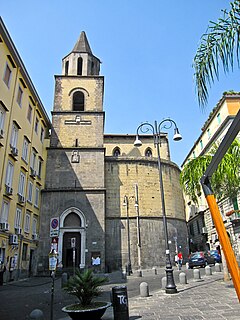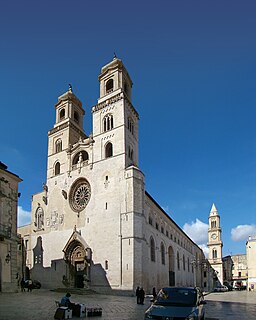
Muzio Attendolo Sforza, was an Italian condottiero. Founder of the Sforza dynasty, he led a Bolognese-Florentine army at the Battle of Casalecchio.
Raimondo Orsini del Balzo was a nobleman from the Kingdom of Naples. He was Count of Soleto (1382), Prince of Taranto (1399–1406), Duke of Bari, Grand Constable of the Kingdom of Naples, Gonfalonier of the Holy Roman Church. He was a member of the influential Orsini family of Rome. Although he is considered one of the most important people in the history of southern Italy, relatively little is known about his life.
The Naples Conservatory of Music is a music school located in Naples, Italy. It is situated in the complex of San Pietro a Majella.

San Pietro a Majella is a church in Naples, Italy. The term may also refer to the adjacent Naples music conservatory, which occupies the premises of the monastery that used to form a single complex with the church.

The Diocese of Altamura-Gravina-Acquaviva delle Fonti is a Roman Catholic diocese in Apulia, southern Italy, created in 1986. In that year, the territorial prelature of Altamura e Acquaviva delle Fonti was united with the diocese of Gravina. The present diocese is a suffragan of the archdiocese of Bari-Bitonto.

Giulio Antonio Acquaviva was an Italian nobleman and condottiere. He was 7th Duke of Atri and 1st of Teramo, Count of Conversano and San Flaviano and Lord of Padula and Roseto.

The Muslim settlement of Lucera was the result of the decision of Holy Roman Emperor Frederick II of the Hohenstaufen dynasty (1194–1250) to move 20,000 Sicilian Muslims to Lucera, a settlement in Apulia in southern Italy. The settlement thrived for about 75 years. In 1300, it was sacked by the Christian forces of Charles II of Naples and its Muslim inhabitants were exiled or sold into slavery.
Montréal de Albarno, also known as Fra Moriale was a Provençal mercenary and condottiero.

The 1254 papal election took place following the death of Pope Innocent IV and ended with the choice of Raynaldus de' Conti, who took the name Pope Alexander IV. The election was held in Naples, in the former palazzo of Pietro della Vigna, and required only one day.

Giovanni Guicciardi was an Italian opera singer who sang leading baritone roles in the opera houses of Italy and Portugal. He is most remembered today for having created the role of Count di Luna in Verdi's Il trovatore. He created also several other leading roles in operas by lesser known Italian composers. Guicciardi accumulated a considerable fortune during the course of his career. After his retirement from the stage, he taught without payment in music schools in his native city, Reggio Emilia, and presided over a charity for orphaned musicians. He died in San Polo d'Enza at the age of 64.
Pirro Del Balzo was a southern Italian nobleman, a protagonist of resistance against the House of Aragon kings of Naples and Sicily.
Matteo Villani (1283-1363) was an Italian historian.

Altamura Castle was a castle located in the city of Altamura, now completely demolished. It was located over today's piazza Matteotti and a few remains of it are still visible inside the adjacent buildings, which were built partly with stones and structural elements from the castle. In a warehouse are an ogival arch and some stone coats of arms. A few other remains are found in the adjacent buildings, which were built in the 19th century.

Nicola d'Arienzo was an Italian composer, music pedagogue, and writer on music. He spent his entire career in his native Naples where all but one of his nine of his operas were premiered. His other compositions included instrumental and sacred music and art songs. From 1909 until 1911, d'Arienzo served as the director of the Conservatory of San Pietro a Majella having taught there since 1875. He also wrote several books on the history and theory of music.

Ottavio Serena was an Italian politician, judge, prefect and historian. He is known in his hometown Altamura for his works about local history, such as the Altamuran Revolution (1799). His contribution and the testimonies he collected allowed to shed light on some historical events (such as the killing of Giovanni Firrao and on legendary toponyms.
Marcello Papiniano Cusani was an Italian archbishop, professor of both civil law and canon law as well as founder and rector of the University of Altamura.

Giovanni Pipino di Altamura was an Italian nobleman and condottiero. He belonged to the Pipino noble family, which began with Giovanni Pipino da Barletta and that, after just a few decades, declined.
Giovanni Pipino may refer to:

The Ceva Grimaldi are an Italian noble family established in Southern Italy since the 16th century but whose origins are in Piedmont and Liguria and date back to the 10th century. The main titles associated with this branch of the Ceva family are Marchese di Pietracatella and Duca di Telese.

Porta Matera was one of the main gates of the old city of Altamura. They were part of the City Walls of Altamura, which were completely demolished during the Nineteenth century since they had become useless for defence purposes. The gate itself was demolished in 1872. The monastery Monastero del Soccorso is located on the left side of the gate, while on the right some ruins of the city walls can be seen, presumably saved from destruction because of the bas-relief depicting "Pipino's leg".













